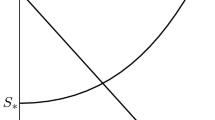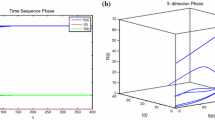Abstract
This paper discusses autonomous and nonautonomous epidemic models with nonlinear incidence rate of saturated mass action and feedback controls. The global asymptotic stability of disease-free equilibrium and the endemic equilibrium of the autonomous system is established using suitable Lyapunov functional. It is shown that by choosing suitable values of feedback control variables, one can make the disease endemic or extinct as time evolves. Moreover, the effect of coefficient of inhibition on the persistence of disease is also discussed. We discuss the permanence, existence, uniqueness and asymptotic stability of an almost periodic solution of the model. The analytical results obtained in this paper are illustrated with the help of numerical examples.







Similar content being viewed by others
References
Abbas, S., Banerjee, M., Hungerbuhler, N.: Existence, uniqueness and stability analysis of allelopathic stimulatory phytoplankton model. J. Math. Anal. Appl. 367, 249–259 (2010)
Abbas, S., Sen, M., Banerjee, M.: Almost periodic solution of a non-autonomous model of phytoplankton allelopathy. Nonlinear Dyn. 67, 203–214 (2012)
Bohr, H.: Almost periodic functions. Chelsea, reprint (1947)
Bohr, H.: On the theory of almost periodic functions. Acta Math. 45, 101–214 (1925)
Brauer, F., Chavez, C.C.: Mathematical Models in Population Biology and Epidemiology. Springer, New York (2001)
Capasso, V., Serio, G.: A generalization of the Kermack–Mckendric deterministic epidemic model. Math. Biosci. 42, 43–61 (1978)
Chen, F.: On a nonlinear nonautonomous predator-prey model with diffusion and distributed delay. J. Comput. Appl. Math. 180, 33–49 (2005)
Chen, F.D.: Almost periodic solution of the non-autonomous two species competitive model with stage structure. Appl. Math. Comput. 181, 685–693 (2006)
Chen, F.: The permanence and global attractivity of Lotka–Volterra competition system with feedback controls. Nonlinear Anal. Real World Appl. 7, 133–143 (2006)
Chen, F.: Permanence in nonautonomous multi-species predator-prey system with feedback controls. Appl. Math. Comput. 173, 694–709 (2006)
Chen, F.D., Li, Z., Chen, X., Jitka, L.: Dynamic behaviours of a delay differential equation model of plankton allelopathy. J. Comput. Appl. Math. 206, 733–754 (2007)
Chen, L., Sun, J.: Global stability of an SI epidemic model with feedback controls. Appl. Math. Lett. 28, 53–55 (2014)
Chesson, P.: Understanding the role of environment variation in population and community dynamics. Theor. Popul. Biol. 64, 253–254 (2003)
Cui, J., Takeuchi, Y.: Permanence, extinction and periodic solution of predator-prey system with Beddington–DeAngelis functional response. J. Math. Anal. Appl. 317, 464–474 (2006)
Ding, H.S., N’Guérékata, G.M.: A note on the existence of positive bounded solutions for an epidemic model. Appl. Math. Lett. 26, 881–885 (2013)
Dry, S., Leach, M.: Epidemics: Science, Governance, and Social Justice. Earthsacan, London (2010)
Fan, M., Kuang, Y.: Dynamics of a nonautonomous predator-prey system with Beddington–DeAngelis functional response. J. Math. Anal. Appl. 295, 15–39 (2004)
Fink, A.M.: Almost periodic differential equations. Lecture Notes in Mathematics, vol. 377. Springer, Berlin (1974)
Gopalsamy, K., Weng, P.-X.: Feedback regulation of logistic growth. Int. J. Math. Math. Sci. 16, 177–192 (1993)
Guihua, L., Wang, W.: Bifurcation analysis of an epidemic model with nonlinear incidence. Appl. Math. Comput. 214, 411–423 (2009)
Heesterbeek, J.A.P.: Mathematical Epidemiology of Infectious Diseases: Model Building, Analysis and Interpretation. Wiley, Chicago (2000)
Hethcote, H.W.: The mathematics of infectious diseases. SIAM Rev. 42, 599–653 (2000)
Hethcote, H.W., Van den Driessche, P.: Some epidemiological models with nonlinear incidence. J. Math. Biol. 29, 271–287 (1991)
Hethcote, H.W., Levin, S.A.: Periodicity in Epidemiological Models, Applied Mathematical Ecology. Springer, Berlin (1989)
Lahrouz, A., Omari, L., Kiouach, D.: Global analysis of a deterministic and stochastic nonlinear SIRS epidemic model. Nonlinear Anal. Model. Control 16, 59–76 (2011)
Lefschetz, S.: Stability of Nonlinear Control System. Academic Press, New York (1965)
Liao, X., Zhou, S., Chen, Y.: Permanence and global stability in a discrete n-species competition system with feedback controls. Nonlinear Anal. Real World Appl. 9, 1661–1671 (2008)
Lin, X., Chen, F.: Almost periodic solution for a Volterra model with mutual interference and Beddington–DeAngelis functional response. Appl. Math. Comput. 214, 548–556 (2009)
Liu, B., Duan, Y., Luan, S.: Dynamics of an SI epidemic model with external effects in a polluted environment. Nonlinear Anal. Real World Appl. 13, 27–38 (2012)
Nakata, Y., Kuniya, T.: Global dynamics of a class of SEIRS epidemic models in a periodic environment. J. Math. Anal. Appl. 363, 230–237 (2010)
Rinaldi, S., Muratori, S., Kuznetsov, Y.: Multiple attractors, catastrophe and chaos in seasonally perturbed predator-prey communities. Bull. Math. Biol. 55, 15–35 (1993)
Ruan, S., Wang, W.: Dynamical behavior of an epidemic model with a nonlinear incidence rate. J. Differ. Equ. 188, 135–163 (2003)
Sun, G.-Q., Jin, Z., Liu, Q.-X., Li, L.: Pattern formation in a spatial SI model with non-linear incidence rates. J. Stat. Mech. Theory Exp. 11, P11011 (2007)
Sun, G.-Q., Jin, Z., Liu, Q.-X., Li, L.: Chaos induced by breakup of waves in a spatial epidemic model with non-linear incidence rates. J. Stat. Mech. Theory Exp. 8, P08011 (2008)
Sun, G.-Q., Liu, Q.X., Jin, Z., Chakraborty, A., Li, B.L.: Influence of infection rate and migration on extinction of disease in spatial epidemics. J. Theor. Biol. 264, 95–103 (2010)
Sun, G.-Q.: Pattern formation of an epidemic model with diffusion. Nonlinear Dyn. 69, 1097–1104 (2012)
Tripathi, J.P., Abbas, S.: Almost periodicity of a modified leslie-gower predator-prey system with crowley-martin functional response. In: Mathematical Analysis and Its Applications, pp. 309–317. Springer India (2015)
Tripathi, J.P., Abbas, S., Thakur, M.: Stability analysis of two prey one predator model. AIP Conf. Proc. 1479, 905–909 (2012)
Tripathi, J.P., Abbas, S., Thakur, M.: Local and global stability analysis of two prey one predator model with help. Commun. Nonlinear Sci. Numer. Simul. 19, 3284–3297 (2014)
Tripathi, J.P., Abbas, S., Thakur, M.: A density dependent delayed predator-prey model with Beddington–DeAngelis type function response incorporating a prey refuge. Commun. Nonlinear Sci. Numer. Simul. 22, 427–450 (2015)
Tripathi, J.P., Abbas, S., Thakur, M.: Dynamical analysis of a prey-predator model with Beddington–DeAngelis type function response incorporating a prey refuge. Nonlinear Dyn. 80, 177–196 (2015)
Tripathi, J.P.: Almost periodic solution and global attractivity for a density dependent predator-prey system with mutual interference and Crowley-Martin response function. Differ. Equ. Dyn. Syst. (2016). doi:10.1007/s12591-016-0298-6
Tripathi, J.P., Tyagi, S., Abbas, S.: Global analysis of a delayed density dependent predator-prey model with Crowley–Martin functional response. Commun. Nonlinear Sci. Numer. Simul. 30, 45–69 (2016)
Wang, X., Liu, X., Xie, W.C., Xu, W., Xu, Y.: Global stability and persistence of HIV models with switching parameters and pulse control. Math. Comput. Simul. 123, 53–67 (2016)
Wang, Q., Dai, B.X.: Almost periodic solution for n-species Lotka–Volterra competitive systems and feedback controls. Appl. Math. Comput. 200(1), 133–146 (2008)
Xia, Y., Cao, J., Zhang, H., Chen, F.: Almost periodic solutions of n-species competitive system with feedback controls. J. Math. Anal. Appl. 294, 503–522 (2004)
Xiao, D., Ruan, S.: Global analysis of an epidemic model with nonmonotone incidence rate. Math. Biosci. 208, 419–429 (2007)
Xiao, Y., Sanyi, T.: Dynamics of infection with nonlinear incidence in a simple vaccination model. Nonlinear Anal. Real World Appl. 11, 4154–4163 (2010)
Xu, Y., Feng, J., Li, J., Zhang, H.: Stochastic bifurcation for a tumor-immune system with symmetric Levy noise. Phys. A Stat. Mech. Appl. 392(20), 4739–4748 (2013)
Xu, Y., Feng, J., Li, J., Zhang, H.: Levy noise induced switch in the gene transcriptional regulatory system. Chaos Interdiscip. J. Nonlinear Sci. 23(1), 013110 (2013)
Zhang, H., Xu, W., Chen, L.: A impulsive infective transmission SI model for pest control. Math. Methods Appl. Sci. 30, 1169–1184 (2007)
Zhang, T., Liu, J., Teng, Z.: Dynamic behaviour for a nonautonomous SIRS epidemic model with distributed delays. Appl. Math. Comput. 214, 624–631 (2009)
Zhang, W., Xu, Y., Hui, Y.: Levy noise induced stochastic resonance in an FHN model. Sci. China Technol. Sci. 59(3), 371–375 (2016)
Zhang, T., Teng, Z.: On a nonautonomous SEIRS model in epidemiology. Bull. Math. Biol. 69, 2537–2559 (2007)
Zhang, T., Teng, Z.: Permanence and extinction for a nonautonomous SIRS epidemic model with time delay. Appl. Math. Model. 33, 1058–1071 (2009)
Zhang, F., Zhao, X.Q.: A periodic epidemic model in a patchy environment. J. Math. Anal. Appl. 325, 496–516 (2007)
Acknowledgments
We are very thankful to the anonymous reviewers and the handling editor for their constructive comments and suggestions which helped us to improve the quality of the paper. This work is fully supported by Central University of Rajasthan, India
Author information
Authors and Affiliations
Corresponding author
Rights and permissions
About this article
Cite this article
Tripathi, J.P., Abbas, S. Global dynamics of autonomous and nonautonomous SI epidemic models with nonlinear incidence rate and feedback controls. Nonlinear Dyn 86, 337–351 (2016). https://doi.org/10.1007/s11071-016-2892-0
Received:
Accepted:
Published:
Issue Date:
DOI: https://doi.org/10.1007/s11071-016-2892-0




